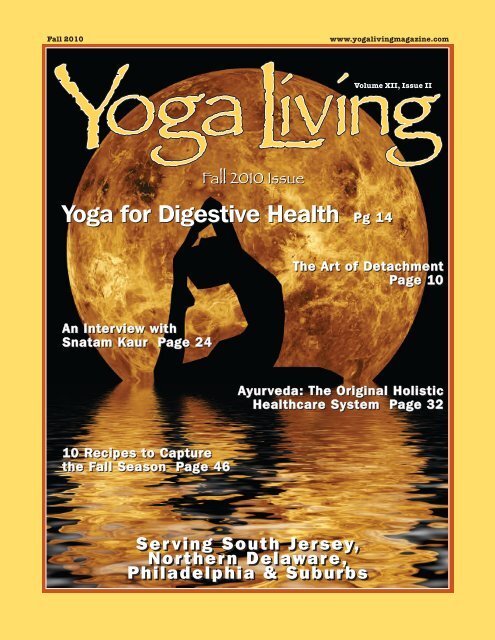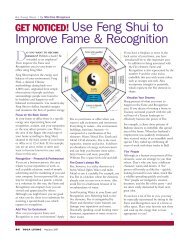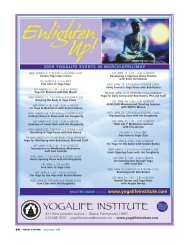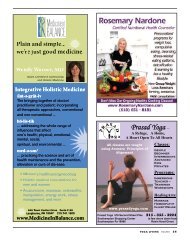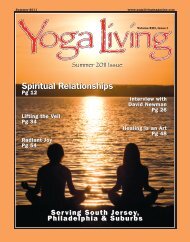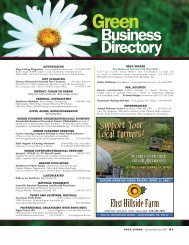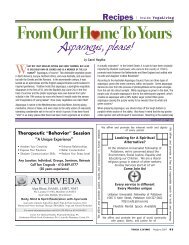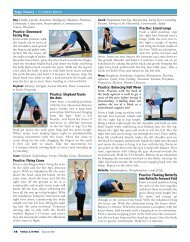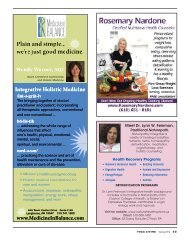YogaWebFall10 1_16.pdf - Yoga Living Magazine
YogaWebFall10 1_16.pdf - Yoga Living Magazine
YogaWebFall10 1_16.pdf - Yoga Living Magazine
You also want an ePaper? Increase the reach of your titles
YUMPU automatically turns print PDFs into web optimized ePapers that Google loves.
Fall 2010<br />
www.yogalivingmagazine.com<br />
Volume XII, Issue II<br />
Fall 2010 Issue<br />
<strong>Yoga</strong> for Digestive Health Pg 14<br />
The Art of Detachment<br />
Page 10<br />
An Interview with<br />
Snatam Kaur Page 24<br />
Ayurveda: The Original Holistic<br />
Healthcare System Page 32<br />
10 Recipes to Capture<br />
the Fall Season Page 46<br />
Ser ving South Jersey,<br />
Northern Delaware,<br />
Philadelphia & Suburbs
Teaching Power <strong>Yoga</strong> with Spirit<br />
A Weekend Intensive Program<br />
with Erika Tenenbaum and Bob Butera, Phd<br />
September 25 – 26th, 2010<br />
Learn how to:<br />
• Teach inner-peace for vigorous approach to practice<br />
• Teach <strong>Yoga</strong> philosophy in any class forum<br />
• Enlighten personal intention for a profound practice<br />
• Take Vinyasa flow into deeper levels of consciousness<br />
• Create a safe environment for practice and avoid student injuries<br />
Schedule: Saturday 9-5, Sun 11-5<br />
Fees: $225 pre-register, $250 (1 week prior to event or less)<br />
Reserve your space today!<br />
821 West Lancaster Avenue | Wayne, Pennsylvania 19087<br />
610-688-7030 | yogalifeinstitute@verizon.net | www.yogalifeinstitute.com<br />
2 YOGA LIVING Fall 2010
<strong>Yoga</strong>Life Meditation Programs<br />
Fall 2010<br />
Meditation Fundamentals<br />
13-Week Course: Sept – Dec, 2010<br />
• Overcome Mental Chatter<br />
• Go Beyond Positive Thinking<br />
• How to Meditate Daily<br />
• Tools for Relaxation, Energy<br />
• Reduce Stress<br />
• Transform Your Life<br />
Free Introductory Classes<br />
Sun, Sept 12: 9 -10:30 AM<br />
Mon, Sept 13: 7:35 – 9 PM<br />
Winter 2011<br />
Meditation For Your Type<br />
16-Week Course: Jan – May, 2011<br />
• Find a Meditation Style That<br />
Works for YOU<br />
• Learn 6 Different Styles of<br />
Meditation: Breath, Mantra,<br />
Visualization, Contemplation,<br />
Mindfulness & Conceptual<br />
Free Introductory Classes<br />
Sun, Jan 2: 9 -10:30 AM<br />
Mon, Jan 3: 7:35 – 9 PM<br />
Meditation programs are good for beginners & experienced<br />
practitioners who want to deepen personal practice.<br />
Program Components: Weekly Group Classes, Weekly Email Lessons, Weekly Video<br />
Lectures & Weekly Supplemental <strong>Yoga</strong> & Meditation Classes<br />
821 West Lancaster Avenue | Wayne, PA 19087<br />
610-688-7030 | yogalifeinstitute@verizon.net<br />
YOGA LIVING YOGA January/February LIVING Fall 2010 201017<br />
3
Local Resources for Healthy <strong>Living</strong>!<br />
Fall 2010<br />
7 | Contributors<br />
8 | Editorial<br />
By Dr. Bob Butera<br />
<strong>Yoga</strong><br />
Theory<br />
10 | The Art of Detachment<br />
Eknath Easwaran<br />
14 | <strong>Yoga</strong> Therapy for<br />
Digestive Health<br />
By Kristen Butera<br />
20 | Breast Cancer Prevention<br />
& Recovery<br />
By Christy Selfridge<br />
22 | Book Reviews<br />
24 | An Interview with<br />
Snatam Kaur<br />
ADVERTISERS ISSUE DEADLINE:<br />
Winter 2011<br />
DECEMBER 1 2010<br />
Psychology<br />
& Health<br />
28 | Caring for Our Species by<br />
Caring for Others and<br />
Our Planet<br />
By Michael Cheikin<br />
32 | Ayurveda: The Original<br />
Holistic Healthcare System<br />
By Lynda Lyng<br />
34 | After the Relationship<br />
Is Done<br />
By Joe White<br />
36 | Coach Thyself: Peak Intellect?<br />
By Michael Reddy, Ph.D.<br />
Healthy<br />
Family<br />
38 | Actor and Avatar<br />
By Anthony Michael Rubbo<br />
46 & 48 | Savoring the<br />
Fall Harvest:<br />
10 Recipes to<br />
Capture the Season<br />
By Kristen Butera<br />
Delaware and<br />
S. Jersey<br />
50<br />
YOGA =<br />
SELF-TRANSFORMATION<br />
| Delaware Section<br />
52 | South Jersey Section<br />
Directories<br />
40-42 | Holistic Resource Directory<br />
43 | Green Business Directory<br />
Look up businesses that support<br />
the environment<br />
44 | Holistic Shop Directory<br />
52-55 | <strong>Yoga</strong> Directory:<br />
Local places by county for study/classes<br />
56 | Advertisers Directory<br />
Our listings help you find holistic<br />
practitioners for all your needs.<br />
Events<br />
57 | Events Listings<br />
Join holistic events, retreats and<br />
on-going groups<br />
<strong>Yoga</strong> <strong>Living</strong> Online! www.yogalivingmagazine.com<br />
4 YOGA LIVING Fall 2010
YOGA LIVING Fall 2010 5
Sustainable Medicine:<br />
Where Modern Medicine meets Holistic Care<br />
Richard G. Fried, M.D.<br />
Board Certified, Family Practice<br />
Pam Gordon, M.D.<br />
Board Certified, Family Practice<br />
Tired of all the drugs, but cautious about unproven, expensive alternative care?<br />
• Full-service primary care for the whole family<br />
• Natural (herbal, Homeopathic, Ayurvedic)<br />
medicine where possible<br />
• Appropriate conventional treatment when necessary<br />
• Holistic newborn, pediatric and women’s healthcare<br />
• Over 25 years’ experience in developmental<br />
disabilities, ADHD and autism<br />
• 24-hour on-call from our own doctors<br />
• Same-day appointments for urgent care<br />
• Most insurance plans accepted<br />
Now accepting new patients with most insurance plans.<br />
The Kimberton Clinic– your doctors for life!<br />
www.kimbertonclinic.com • 610.933.0708<br />
6 YOGA LIVING Fall 2010
Inside <strong>Yoga</strong><strong>Living</strong> | Contributors<br />
Doers | Player | Teacher | Representative | A Voice | Impetus | Reflection | Learning | Imagine<br />
><br />
Selfridge<br />
is the Founder of Christina's<br />
Hair Hats, a company that<br />
designs fashionable solutions<br />
for women who are experiencing<br />
hair loss. She also is a hair<br />
stylist at Nicholas Sebastian<br />
Hair Salon in Newtown<br />
Square PA. Christy is currently<br />
in teacher training at The <strong>Yoga</strong><br />
Life Institute with the intention<br />
of teaching classes for cancer<br />
survivors in the future.<br />
To learn more visit<br />
www.christinashairhats.com.<br />
Breast Cancer Prevention & Recovery<br />
page 20<br />
><br />
White<br />
is the President and Founder of<br />
Get Life Coaching. He works<br />
with individuals and businesses<br />
in DE, PA and NJ to help them<br />
achieve a deeper and more<br />
fulfilling life and purpose.<br />
He conducts life coaching<br />
certification courses and has<br />
trained therapists and<br />
counselors in coaching<br />
techniques. As a keynote<br />
speaker and on-air expert, he<br />
brings depth, insights and<br />
energy into his interactions.<br />
To learn more, visit<br />
www.getlifecoaching.com.<br />
After the Relationship Is Done<br />
page 34<br />
<br />
Cheikin | MD<br />
is a holistic physician,<br />
Board Certified in<br />
Physical Medicine and<br />
Rehabilitation (Physiatry), Pain<br />
Management, Spinal Cord<br />
Medicine and<br />
Electro-diagnostic Medicine.<br />
Contact him at<br />
drc@c4oh.org.<br />
Caring for Our Species by Caring<br />
for Others and Our Planet<br />
page 28<br />
Anthony >><br />
Michael<br />
Rubbo | MHS<br />
is a consultant to<br />
educa tion and industry,<br />
and the author of books on<br />
person al leadership and meditation.<br />
He is current ly writing<br />
a novel and collabor ating on a<br />
production that pro motes the<br />
spiritual life style. If you have<br />
questions or comments, you<br />
can contact him at anthony -<br />
michael133@ gmail.com.<br />
Actor and Avatar<br />
page 38<br />
Michael >><br />
Reddy | PH.D<br />
CPC, ELI-MP<br />
is a certified Wellness Coach<br />
who also employs Family<br />
Constellation Work to<br />
remove ancestral blocks<br />
to greater health and<br />
fulfillment. He has<br />
consulted, been a CTO,<br />
and taught shamanic<br />
spirituality for many years.<br />
He specializes in helping<br />
wellness professionals find<br />
their true alignment and<br />
new tools for helping.<br />
Learn more at<br />
www.reddyworks.com.<br />
Coach Thyself: Peak Intellect?<br />
page 36<br />
YOGA LIVING Fall 2010 7
Letter From the Publisher<br />
<strong>Yoga</strong> <strong>Living</strong><br />
Your Healthy Lifestyle Guide<br />
“The secret of health for both the mind and body<br />
is not to mourn for the past, not to worry about<br />
the future, or not to anticipate troubles, but to<br />
live in the present moment wisely and earnestly.”<br />
- The Buddha<br />
The psychology of <strong>Yoga</strong> teaches that the majority of human suffering is caused<br />
by the resistence to the truth that everything changes. We tend to get attached<br />
very easily and because of those attachments, resist the truth of change even<br />
though the evidence of it is all around us. Each day changes as the sun travels across<br />
the sky, the seasons change and with them we change in so many different ways. Are<br />
you the same person that you were five years ago? Probably not!<br />
This concept of change is difficult because of the pain that comes along with it. As<br />
things change, we are forced to adjust to new situations that bring with them challenge<br />
and discomfort. At night, we have to be kept warm; our bodies feel hungry in just hours<br />
after eating. Hunger for those who have plenty of food is not a big pain, but imagine the<br />
pain associated with not having enough food. Take this change to more substantial<br />
issues like our body aging. Ultimately, death is the biggest change that we fear and<br />
avoid facing.<br />
Conversely, change can be exciting and create an abundance of anticipation, such as<br />
new job or love interest or first signs of the leaves changing color in early Fall. In this<br />
case, the anticipation brings potential expectations that lead to inevitable disappointment<br />
as things continue to change in ways that we could not originally envision.<br />
O N<br />
TRANSFORMATION<br />
Fall 2010<br />
Volume XI, Issue VII<br />
<br />
Publisher<br />
ROBERT BUTERA, PhD<br />
Editor<br />
KRISTEN BUTERA<br />
Art Director<br />
AMIE HANNAH<br />
Partners Press, Oaks, PA<br />
Graphic Artist<br />
MARIE KOZLOWSKI<br />
Partners Press, Oaks, PA<br />
Advertising<br />
ANGELA NEVIUS<br />
Published by:<br />
YOGALIFE INSTITUTE, INC.<br />
821 W. Lancaster Avenue<br />
Wayne, PA 19087<br />
610-688-7030<br />
www.yogalivingmagazine.com<br />
<strong>Yoga</strong> philosophy tells us that the key to a balanced mind and a happy life is to expect<br />
change versus trying to resist it. The popular line, “go with the flow,” has it roots in<br />
ancient philosophers. Human beings have been coping with changes since the beginning<br />
of time. One key way to understand the nature of change is to examine the things that<br />
are changing in your life and simply pay attention to the transitions. Notice your<br />
emotions, your excitements and your sadness. Don’t rush to get over change, simply<br />
savor life as it is. Try to not live in the past or dream about the future, but observe the<br />
changes as they happen and come into the beauty of living in the present moment.<br />
Practice going with the flow as we change from warm Fall days of late September into<br />
the cooler days of early December!<br />
Enjoy the journey,<br />
Bob Butera, PhD, <strong>Yoga</strong> <strong>Living</strong> Publisher, Director of the <strong>Yoga</strong>Life Institute in Devon, PA, writer, and<br />
national trainer of <strong>Yoga</strong> Teachers<br />
<strong>Yoga</strong> <strong>Living</strong>, Your Healthy Lifestyle<br />
Guide, promotes the field of <strong>Yoga</strong> as a<br />
healthy lifestyle. The practice of a<br />
Traditional <strong>Yoga</strong> program includes<br />
each facet of life. This magazine intro<br />
duces readers to resources for heal -<br />
thy living. Please share your copy of<br />
<strong>Yoga</strong> <strong>Living</strong> with your friends. Con tact<br />
us at 610-688-7030 or at info@yogalivingmagazine.com.<br />
Advertisers go<br />
to www.yoga living maga zine.com for a<br />
media kit.<br />
8 YOGA LIVING Fall 2010
YOGA LIVING Fall 2010 9
<strong>Yoga</strong> Theory | by Eknath Easwaran<br />
The Art of Detachment<br />
WHEN SCIENTISTS BEGAN CONTEMPLATING<br />
THE CONQUEST OF SPACE, the first<br />
problem they encountered – a problem<br />
that had to be solved before they could make any<br />
headway at all – was how to get beyond the pull of<br />
the earth’s gravity. A rocket has to build up a speed<br />
of twenty-five thousand miles per hour to escape<br />
this pull, and engineers quickly ran into a kind of<br />
“catch-22”: to attain this speed, an ordinary rocket<br />
would have to be so large that its sheer weight<br />
would never allow it to escape the pull of gravity.<br />
Yet the human spirit delights in overcoming<br />
obstacles. Undaunted, scientists finally came up<br />
with the idea of a multistage rocket,<br />
with one or more independent boosters<br />
attached. Each booster holds fuel, which<br />
it burns in one great leap upward. As<br />
soon as its fuel is expended, its job is<br />
done and the booster is dropped,<br />
freeing the spacecraft from the burden<br />
of its great weight.<br />
Exploring inner space confronts us with<br />
a similar problem. What makes it so<br />
difficult to turn inward in meditation is<br />
the pull of objects and experiences<br />
outside us, the attraction of the physical world.<br />
Even memories, anxieties, plans, and so on draw<br />
their power from experiences of the senses: things<br />
we have felt, seen, heard, smelled, or tasted, which<br />
we want (or fear) to experience again.<br />
This attraction is only natural, and there is nothing<br />
inherently wrong in it – just as gravity is natural,<br />
and there is nothing wrong with staying on earth.<br />
Problems arise only when we want more: new<br />
worlds to explore, a higher reality. Then we<br />
discover that the pull of our body, our senses, and<br />
our private, personal satisfactions is what keeps us<br />
earthbound, preventing us from soaring to those<br />
heights where we can look back and see that all of<br />
existence is one indivisible whole.<br />
To rise above this pull, we have to build up a great<br />
deal of momentum. Just as in launching a rocket,<br />
immense power is required. But where are we to<br />
get such power? Space scientists can experiment<br />
with explosive mixtures such as liquid hydrogen<br />
and oxygen, but what do we use as human beings?<br />
The mystics give the answer: the power that drives<br />
a human being is desire. Our desires are our fuel.<br />
I am full of admiration for the world’s astronauts,<br />
who undergo such arduous training in their desire<br />
to go where no one has gone before. That desire is<br />
so great that it overrides all lesser predilections. For<br />
the sake of a few days in outer space and the thrill<br />
of seeing the earth floating free in a sea<br />
of stars, they are willing to learn all<br />
kinds of strange new skills and put up<br />
with endless deprivations.<br />
To reach our true Self, called the Atman<br />
in Sanskrit, shining like the full moon in<br />
the depths of consciousness, requires<br />
the same measure of dedication and<br />
training – and here, too, the secret is<br />
desire. If it is the power of our personal<br />
desires that keeps us earthbound, it is<br />
that same power, when released and<br />
harnessed, that will provide the fuel to launch us<br />
into higher consciousness.<br />
To apply this we too need a booster rocket strategy,<br />
and the mystics of all religions have given us one,<br />
based on their own personal experience. In English<br />
it is called detachment: the art of withdrawing<br />
desire from lesser things, letting them fall away, so<br />
as to harness their power to reach the heights of<br />
what a human being can attain.<br />
LIFE AT ITS FULLEST<br />
This journey brings an overflowing, ever-present<br />
sense of joy. The Buddha, who almost never talked<br />
about himself, once admitted quietly, “I am the<br />
happiest of mortals. There is no one happier than<br />
continued on page 12<br />
10 YOGA LIVING Fall 2010
<strong>Yoga</strong>Life Weekend Intensive Programs<br />
Prenatal <strong>Yoga</strong> Teacher Training<br />
with Randi Coen-Gilbert<br />
November 19-21, 2010<br />
• Special considerations of teaching Prenatal students<br />
• Anatomical & Physiological changes & related <strong>Yoga</strong> Poses<br />
• Class Sequences & Poses to relieve common discomforts<br />
• Breathing, Visualization & Stress management techniques<br />
• <strong>Yoga</strong> Lifestyle tips for a healthy pregnancy & birth<br />
Open to perinatal health professionals, childbirth educators,<br />
doulas and yoga instructors interested in offering a<br />
complimentary, mind-body approach to pregnancy.<br />
<strong>Yoga</strong> Therapy for Depression<br />
with Bob Butera, Mary Noone & Jessica Singerman<br />
December 3-5, 2010<br />
• Comprehensive Lifestyle approach for managing Depression<br />
• Postures, Breathing and Meditation for home practice<br />
• Increase physical energy, reduce anxiety & quiet the mind<br />
• Connect to self & create deeper levels of healing<br />
• Strip away obstacles that separate you from source.<br />
All levels of students are welcome.<br />
821 West Lancaster Avenue | Wayne, PA 19087<br />
610-688-7030 | yogalifeinstitute@verizon.net<br />
www.yogalifeinstitute.com
<strong>Yoga</strong> Theory | by Eknath Easwaran<br />
I am.” This is the joy for which every one of us is<br />
born. Not tuppenny-ha’penny pleasures, not tinsel<br />
delights or costume jewelry, but a jewel that is<br />
beyond price: the jewel hidden in the very depths<br />
of our hearts.<br />
Detachment not only releases joy; it is also the<br />
secret of health. It is the best medical insurance in<br />
the world, and not only because it can keep us free<br />
from physical habits that sap our vitality. Most<br />
illness has a serious emotional element. While<br />
there is an important place for physical measures<br />
in the treatment of disease, a mind at peace and a<br />
heart flooded with love can release healing powers<br />
that strengthen and revitalize the physical system.<br />
Strength can be regained even after years of<br />
emotional instability. In extreme cases, I believe,<br />
recovery can be brought about even from what<br />
seems a terminal illness.<br />
Today, of course, it is widely appreciated that<br />
because of advances in medical knowledge, we can<br />
expect to live much longer than was reasonable at<br />
the beginning of the twentieth century. But we can<br />
lead lives that are not only longer but richer, more<br />
loving, and more productive. The next steps in<br />
stretching the limits of human health and<br />
longevity, I believe, will not be in biotechnology.<br />
They will come from learning to govern the way<br />
we think and feel. Detachment is a longevity skill.<br />
Freedom from compulsive emotional entanglements<br />
is the best insurance against stress. More than that,<br />
by opening a window onto a fuller, loftier view of<br />
life than that dictated by self-interest, detachment<br />
brings a sense of purpose. Without a reason for<br />
living, the human being withers and dies inside.<br />
However paradoxical it may sound, it is detachment<br />
that enables us to give ourselves wholeheartedly to<br />
worthwhile work without ever getting depressed,<br />
despondent, or burned out – right into the last<br />
days of our lives.<br />
Most people who work hard – which means most<br />
men and women in this country – bring their work<br />
home with them, yapping like a poodle at their<br />
heels. At the dinner table, when they sit thinking<br />
about their deadlines and responsibilities, the<br />
poodle is nestled under the chair, whining away.<br />
They curl up with it at night and dream about<br />
reports that haven’t been filed, statistics that don’t<br />
point to the right conclusions, mail that hasn’t<br />
been responded to or that has been sent out with<br />
the wrong memo attached. Detachment gives us<br />
the capacity to concentrate completely while on<br />
the job and to drop our work completely when we<br />
walk out the door.<br />
A detached worker is a reliable worker, a cheerful<br />
worker, a harmonious worker. And when you can<br />
drop your work completely at the end of the day,<br />
you arrive home ready to give all your love to your<br />
family and friends. You feel fresh, relaxed. You have<br />
no need to give vent to the kind of frustration that<br />
millions of good people air: “Leave me alone. I’ve<br />
had a misera-ble day!” Mahatma Gandhi worked<br />
fifteen hours a day for fifty years for all of us who<br />
want a politically free world. When he was asked,<br />
“Don’t you want a vacation, Mr. Gandhi?” he said<br />
quietly, “I’m always on vacation.” It wasn’t a<br />
flippant reply; he meant every word of it. So don’t<br />
content yourself with two weeks in July or two<br />
weeks at a ski resort in January. You deserve three<br />
hundred and sixty-five days of vacation, and that is<br />
exactly what detachment can give you.<br />
Detachment brings this kind of protection at every<br />
stage of life. Many of the physical problems<br />
associated with old age, for example, are not at all<br />
a necessary part of aging. The fact that they are<br />
common does not mean they are inevitable. Not<br />
only senility but even certain physical problems<br />
may well have more to do with life-style and<br />
thought-style than with changes triggered by some<br />
biological clock.<br />
As researchers have observed, we have focused so<br />
much on “ordinary aging” – what happens to the<br />
majority – that we have ignored “successful aging,”<br />
which we can observe in men and women like<br />
Mahatma Gandhi, George Bernard Shaw, and<br />
Mother Teresa, who grow in wisdom and vitality<br />
right into the last days of a long, creative, fulfilling<br />
life. I grant you that in the evening of your life you<br />
may not be able to compete successfully on Centre<br />
Court at Wimbledon. But every one of us can<br />
enjoy the vitality, resourcefulness, and unerring<br />
judgment that come from a heart full of love and a<br />
vast reservoir of experience.<br />
▲<br />
Reprinted with permission from "The Art of<br />
Detachment" by Eknath Easwaran (Blue Mountain,<br />
Summer 2009). Copyright 2009 by The Blue<br />
Mountain Center of Meditation, Box 256, Tomales,<br />
CA 94971, www.easwaran.org.<br />
12 YOGA LIVING Fall 2010
Therapeutic & Restorative <strong>Yoga</strong><br />
A Weekend Intensive with Erin Byron, RYT, MA<br />
October 15-17, 2010<br />
Learn <strong>Yoga</strong>’s approach to managing the Mental & Physical concerns of:<br />
• Pain, Digestive Distress, Gastric Concerns, Insomnia & other Common<br />
Chronic Illnesses<br />
• Cancer/Chemotherapy, Radiation, Dialysis, Post-Op Recovery & other Allopathic<br />
Treatments<br />
• Depression, Stress Disorders, Anxiety & Improved Cognitive Function<br />
All Levels Welcome<br />
Schedule: Friday 6:30-8:30 PM Saturday 9-5, Sun 11-4<br />
Fees: $225 pre-reg; $250 (1 week prior to event)<br />
821 West Lancaster Avenue | Wayne, Pennsylvania 19087<br />
610-688-7030 | yogalifeinstitute@verizon.net | www.yogalifeinstitute.com<br />
The Future is for the Fit<br />
Aerobic, Strength & Flexibility Training<br />
It doesn’t matter what your age or current level<br />
of fitness is, the expert trainers at Bodystyling<br />
can help you meet your health & fitness goals.<br />
• Identify your goals<br />
• Assess your fitness level<br />
• Personalize your workout plans<br />
• Learn more about Nutrition<br />
• Manage your Stress<br />
• Achieve long-term results<br />
Call today for your FREE consultation!<br />
YOGA LIVING Fall 2010 13
<strong>Yoga</strong> Theory | by Kristen Butera<br />
YOGA THERAPY for Digestive Health<br />
“Food is, verily, the first among all that is created,<br />
therefore it is said to be the medicine for all. One<br />
who mediates on food as Brahman, surely obtains<br />
all food.” - Taittiriya Upanishad, 2:1<br />
HAVE YOU EVER “CHOKED” IN A PRESSURE FILLED<br />
SITUATION, MADE A“GUT-WRENCHING" DECISION OR<br />
FELT NERVOUS “BUTTERFLIES” BEFORE SPEAKING IN<br />
FRONT OF A LARGE GROUP? If so, then you have had<br />
first-hand experience of some of the effects that a short bout<br />
of stress can have on the digestive system.<br />
Ancient yogis understood that good digestion is key to radiant<br />
health and sought to understand the mind-body connection.<br />
<strong>Yoga</strong> therapists tend to view the digestive system as a very<br />
sensitive mirror of the mind and will encourage a client with<br />
digestive issues to examine overall lifestyle choices, emotions<br />
and other mental components in the healing process. Think of<br />
it like this - the mind is like a sea, the body is the land and<br />
their sphere of interaction is the shore. When the mind is<br />
peaceful and relaxed, the sea is calm. When the mind is<br />
troubled or stressed the sea become turbulent and waves beat<br />
against the shore, tearing away large sections of the land. This<br />
is the psychosomatic process that can result in digestive<br />
distress and disease in the body. Some common examples of<br />
the effects of stress on the digestive system include esophagus<br />
spasms, indigestion, nausea, diarrhea, constipation, stomach<br />
ulcers, celiacs disease, irritable bowel syndrome as well as<br />
other more severe digestive ailments.<br />
When a human being is under stress, the body activates what<br />
we have come to know as the "flight or fight" response in the<br />
central nervous system. In a matter of seconds, most of the<br />
blood in the body gets shunted out from the digestive system<br />
and into the major muscle groups. This has a negative impact<br />
on the contractions of the digestive muscles that help move<br />
food through the body as well as the fluids and secretions that<br />
are needed for healthy digestion. While this particular response<br />
mechanism works well for a person who is in immediate danger<br />
and needs to run (like a caveman saving himself from a large<br />
predator) it also necessitates a period of relaxation and recovery<br />
afterwards. The unfortunate plight of many people is that<br />
they live in a constant state of stress and do not allow enough<br />
time for self-care and relaxation. The body does not know how<br />
to distinguish the stress of running from the proverbial tiger<br />
from the stress of a big meeting at work, a difficult family<br />
situation or even watching a scary movie – it all has the same<br />
impact. The modern American lifestyle is so jammed packed<br />
with activity that just getting out the door to scheduled<br />
“recreational” activities can be stressful.<br />
How <strong>Yoga</strong> Poses Help<br />
<strong>Yoga</strong> poses work on the soft tissues of the body, like a hand<br />
gently squeezing a sponge. When the organs of the digestive<br />
system are compressed in poses, stale and waste-bearing fluids<br />
in those areas are encouraged out of the tissues. Once these<br />
materials are freed up, the body is better able to eliminate<br />
them. When an area is opened or stretched out in a yoga pose,<br />
new life-giving nutrients are able to circulate into the cells. In<br />
this systematic way, yoga poses massage the vital organs<br />
associated with the digestive system, stimulate the digestive<br />
muscles and increase the wave like movements in the body<br />
that are known as Peristalsis. Yogic breathing exercises send<br />
oxygen deep into the cells of the body and help it to absorb<br />
nutrients and excrete waste products thoroughly. In essence,<br />
all of the tools of <strong>Yoga</strong> work together to reduce the stress<br />
response, rebalance the autonomic nervous system and create<br />
a powerful relaxation response that allows the healing functions<br />
of the parasympathetic nervous system to occur.<br />
The Digestive System – A Brief Overview<br />
The digestive tract is a series of hollow organs joined in a long,<br />
twisting tube that includes the mouth, esophagus, stomach,<br />
small intestine, large intestine, rectum and anus. Organs that<br />
help with digestion, but are not part of the digestive tract include<br />
the tongue, saliva glands, pancreas, liver and gallbladder. Parts<br />
of other organ systems, such as the nerves and blood also play<br />
a major role in the digestive process.<br />
The chief goal of the digestive system is to break down huge<br />
macromolecules (proteins, fats and starch) which cannot be<br />
absorbed intact, into smaller molecules (amino acids, fatty<br />
acids and glucose) that can be absorbed across the wall of the<br />
tube and into the circulatory system for dissemination<br />
throughout the body. The process begins in the mouth, where<br />
food and liquids are taken in and is completed in the small<br />
intestine. There are four basic steps in the process:<br />
• Mastication/Ingestion: taking in and chewing/mixing of<br />
food. Chewing food properly is important, as the enzymes<br />
in the saliva start the process of the food breaking down.<br />
• Digestion: the movement of food through the digestive<br />
track in combination with a chemical breakdown of<br />
large molecules of food into smaller molecules.<br />
• Absorption: nutrients become available to all cells in the<br />
body and are utilized by the body cells in metabolism.<br />
• Elimination: the removal of indigestible waste in the<br />
form of urine or feces.<br />
Better Food Choices for Better Digestion<br />
One of the ways that <strong>Yoga</strong> contributes to healthy digestion is<br />
that the practitioner develops better observation skills along<br />
with the ability to slow down eating habits and make healthier<br />
food choices. People seeking a positive quality of mind, relaxation<br />
and good digestive health will naturally choose foods that give<br />
continued on page 16<br />
14 YOGA LIVING Fall 2010
Premium Vitamins, Minerals & Dietary Supplements<br />
Holly Brinton<br />
610 564-6832<br />
hollyyoga@gmail.com<br />
http://www.amway.com/hollybrinton<br />
YOGA LIVING Fall 2010 15
<strong>Yoga</strong> Theory | by Kristen Butera<br />
rise to a sense of balance and harmony. The optimal diet will<br />
vary from person to person, and <strong>Yoga</strong> practices offer a way for<br />
individuals to engage in the self-discovery process and better<br />
understand the relationship between food choices and<br />
mental/physical well being.<br />
Eating as a Meditative Practice<br />
Come to the table relaxed and with awareness, and practice deep<br />
breathing to become more relaxed before eating if necessary.<br />
As you eat, remain aware of the body, breath and mind. Imagine<br />
sitting at the table with a favorite deity or great spiritual teacher.<br />
Stay mindful of posture and keep the spine long. Try not to cross<br />
the legs so fluids and energy can flow freely into the abdomen.<br />
Remain fully aware of the process of chewing and swallowing.<br />
Each taste, temperature and texture can be fully experienced.<br />
Once the meal is complete, remain aware that food has passed<br />
down into the stomach and the digestive process is underway.<br />
Meditation for Digestion:<br />
Sit in Heros pose or Easy pose and<br />
visualize the digestive tract in the<br />
abdomen, becoming fully aware of<br />
all of its movements and sensations.<br />
Use any knowledge of anatomy to<br />
visualize an ideal digestion in progress<br />
in the body. Focus on the natural<br />
rhythm of the breath in the abdomen.<br />
Utilize the visual of the sun resting<br />
at navel center and radiating digestive power. Feel its warmth<br />
digesting the food and sending prana out to different parts of<br />
the body. Stay seated and aware for 5 – 10 min.<br />
<strong>Yoga</strong> Breathing Exercises for Digestive Health:<br />
Abdominal Breathing: This breath stimulates peristalsis and<br />
relaxes the abdomen. It can be performed seated, laying down or<br />
standing. Close the mouth with the inhalation, slow down the<br />
intake of breath and direct it down into the abdomen, expanding<br />
the belly out like a balloon. With an exhalation, prolong the release<br />
of air through the nose and relax the belly back towards the<br />
spine. After some practice, count the length of the inhalation<br />
and exhalation and bring them to an equal count. Repeat 10 – 20x.<br />
As practice progresses, lengthen the count of both. Practice<br />
this breath on its own or in a yoga pose practice session.<br />
YOGA POSES FOR MAINTAINING DIGESTIVE HEALTH<br />
Knees to Chest<br />
From a reclining position, gently<br />
bend the knees and bring the hands<br />
to the back of the thighs or in front<br />
to the shins. With an exhalation,<br />
draw them in towards the body and focus on the abdominal<br />
breath. Hold 30 sec - 2 min.<br />
Cat/Cow<br />
From all fours, bring the hands<br />
under the shoulders and the knees<br />
under the hips. With an inhalation<br />
drop the belly down and tilt the<br />
tailbone upward, gently arching<br />
the low back as the heart, throat<br />
and gaze open slightly upward. With the exhalation, tuck the<br />
tailbone under, round the upper<br />
back as the hands press into the<br />
mat to help spread the shoulder<br />
blades open and relax the head and<br />
neck. Repeat the movements with<br />
the breath, 10 – 20x.<br />
Downward Facing Dog<br />
From a table position, walk the<br />
hands out in front of the shoulders<br />
and spread the fingers and palms<br />
wide. Gently lift the knees off the<br />
earth a couple of inches. Keep the<br />
knees bent, press the chest back towards the thighs, draw the<br />
shoulder blades back and down the body and bring the belly<br />
button back towards the spine. Walk out the legs for a bit until<br />
the body is able to sink both heels down towards the earth.<br />
Breathe and hold 1 – 3 min.<br />
Flowing Standing Forward Fold<br />
From downward dog, walk the feet<br />
up to meet the hands and bring<br />
the body into a standing forward<br />
fold with the feet hips distance<br />
apart. Extend the arms long by<br />
the ears and engage the lower<br />
abdomen. With an inhalation and<br />
a long flat back,<br />
lift the arms and torso and reach up and out<br />
of the lower back into Arching Mountain.<br />
With an exhalation fold forward and<br />
bring the hands to rest on the front of the<br />
shins or thighs. Inhale halfway up into a<br />
flat back and exhale fold forward. Repeat<br />
the combination of movements 2 – 5x.<br />
Finish with a prolonged forward fold and<br />
hold 30 sec – 1 min.<br />
Squat with Ashwini Mudra<br />
Widen the standing position to about<br />
mats distance apart and turn the toes out<br />
to point at approximately 11 and 1 on a<br />
clock. With an exhalation, bend the knees<br />
and bring the buttocks down towards the<br />
earth. If the heels will not comfortably<br />
come to the floor, tuck a folded blanket<br />
or pillow underneath them and rest into<br />
the support. Press palms together to aid<br />
the elbows as they gently encourage the groin to open.<br />
Practice Ashwini Mudra (Horse Seal) while holding the pose<br />
by gently contracting the sphincter<br />
muscles of the anus with the<br />
inhalation and relaxing them on the<br />
exhalation. Hold 30 sec – 2 min.<br />
Note: If the knees are injured or will<br />
simply not sustain a squat, gently sit<br />
back onto the buttocks, turn the feet<br />
out, bring the hands to the ankles<br />
and use the arms to encourage the<br />
groin to open.<br />
continued on page 18<br />
16 YOGA LIVING Fall 2010


